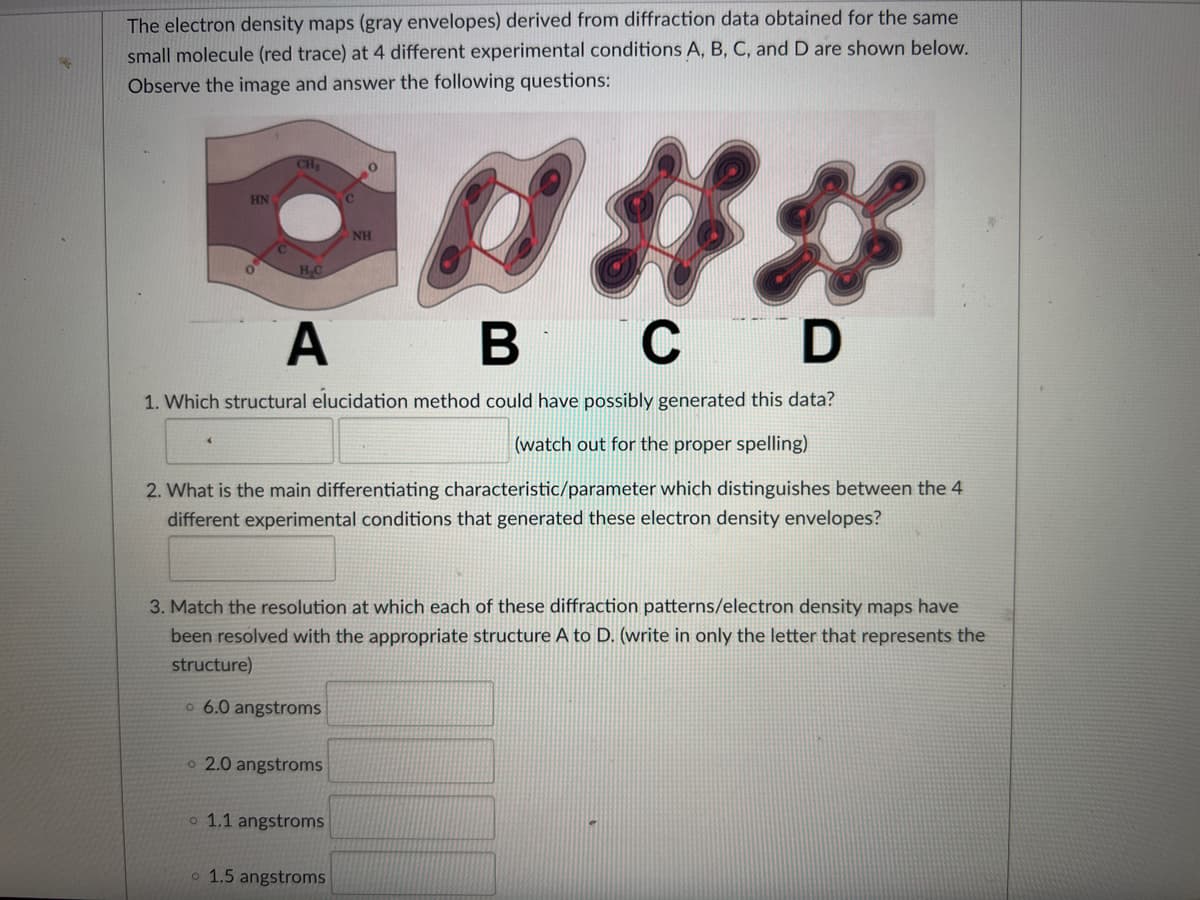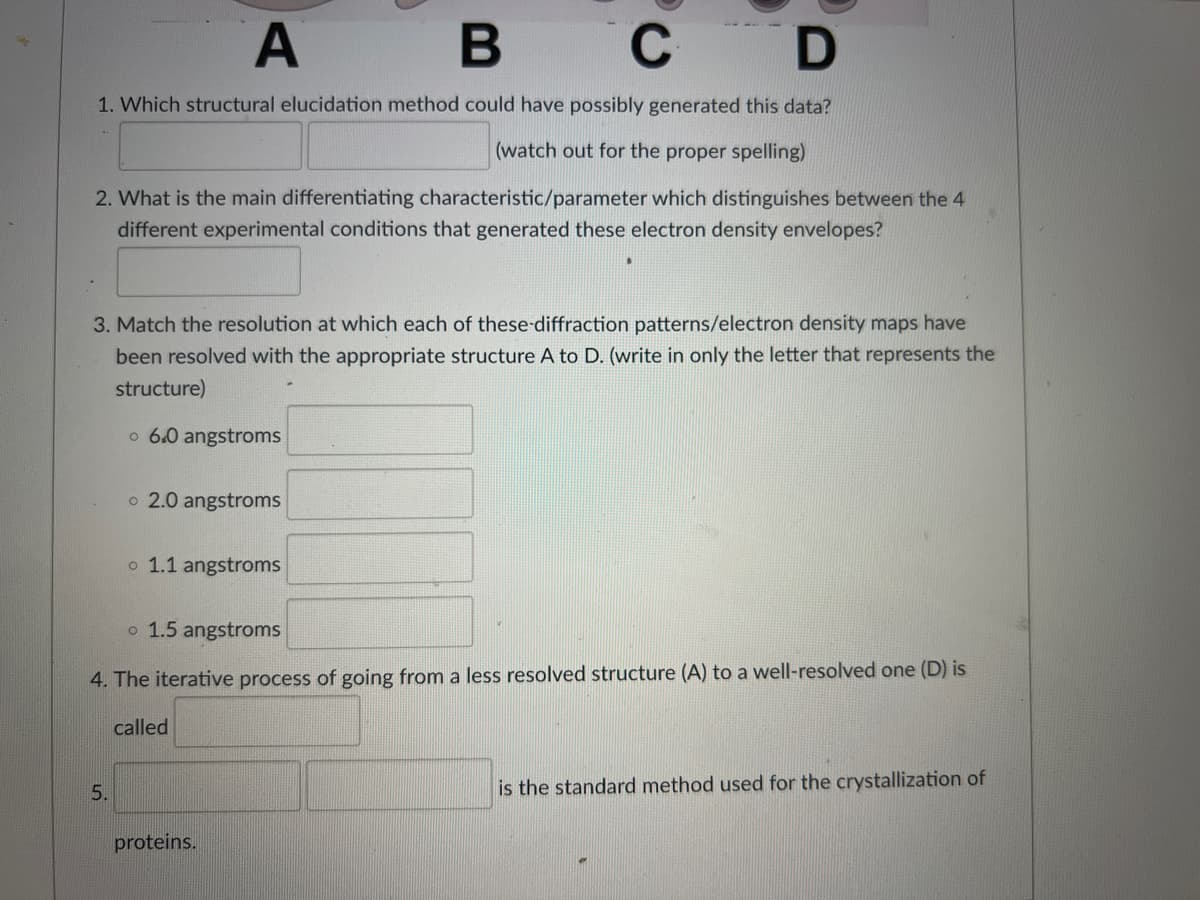The electron density maps (gray envelopes) derived from diffraction data obtained for the same small molecule (red trace) at 4 different experimental conditions A, B, C, and D are shown below. Observe the image and answer the following questions: CH HN NH H.C A B В C D 1. Which structural elucidation method could have possibly generated this data? (watch out for the proper spelling) 2. What is the main differentiating characteristic/parameter which distinguishes between the 4 different experimental conditions that generated these electron density envelopes? 3. Match the resolution at which each of these diffraction patterns/electron density maps have been resolved with the appropriate structure A to D. (write in only the letter that represents the structure) o 6.0 angstroms o 2.0 angstroms o 1.1 angstroms o 1.5 angstroms
The electron density maps (gray envelopes) derived from diffraction data obtained for the same small molecule (red trace) at 4 different experimental conditions A, B, C, and D are shown below. Observe the image and answer the following questions: CH HN NH H.C A B В C D 1. Which structural elucidation method could have possibly generated this data? (watch out for the proper spelling) 2. What is the main differentiating characteristic/parameter which distinguishes between the 4 different experimental conditions that generated these electron density envelopes? 3. Match the resolution at which each of these diffraction patterns/electron density maps have been resolved with the appropriate structure A to D. (write in only the letter that represents the structure) o 6.0 angstroms o 2.0 angstroms o 1.1 angstroms o 1.5 angstroms
Principles of Instrumental Analysis
7th Edition
ISBN:9781305577213
Author:Douglas A. Skoog, F. James Holler, Stanley R. Crouch
Publisher:Douglas A. Skoog, F. James Holler, Stanley R. Crouch
Chapter17: Applications Of Infrared Spectrometry
Section: Chapter Questions
Problem 17.13QAP
Related questions
Question

Transcribed Image Text:The electron density maps (gray envelopes) derived from diffraction data obtained for the same
small molecule (red trace) at 4 different experimental conditions A, B, C, and D are shown below.
Observe the image and answer the following questions:
%23
CH
HN
C.
NH
Ce
HC
A B C D
1. Which structural elucidation method could have possibly generated this data?
(watch out for the proper spelling)
2. What is the main differentiating characteristic/parameter which distinguishes between the 4
different experimental conditions that generated these electron density envelopes?
3. Match the resolution at which each of these diffraction patterns/electron density maps have
been resolved with the appropriate structure A to D. (write in only the letter that represents the
structure)
o 6.0 angstroms
o 2.0 angstroms
o 1.1 angstroms
o 1.5 angstroms

Transcribed Image Text:A
B
1. Which structural elucidation method could have possibly generated this data?
(watch out for the proper spelling)
2. What is the main differentiating characteristic/parameter which distinguishes between the 4
different experimental conditions that generated these electron density envelopes?
3. Match the resolution at which each of these-diffraction patterns/electron density maps have
been resolved with the appropriate structure A to D. (write in only the letter that represents the
structure)
o 6.0 angstroms
o 2.0 angstroms
o 1.1 angstroms
o 1.5 angstroms
4. The iterative process of going from a less resolved structure (A) to a well-resolved one (D) is
called
5.
is the standard method used for the crystallization of
proteins.
Expert Solution
This question has been solved!
Explore an expertly crafted, step-by-step solution for a thorough understanding of key concepts.
This is a popular solution!
Trending now
This is a popular solution!
Step by step
Solved in 2 steps with 2 images

Knowledge Booster
Learn more about
Need a deep-dive on the concept behind this application? Look no further. Learn more about this topic, chemistry and related others by exploring similar questions and additional content below.Recommended textbooks for you

Principles of Instrumental Analysis
Chemistry
ISBN:
9781305577213
Author:
Douglas A. Skoog, F. James Holler, Stanley R. Crouch
Publisher:
Cengage Learning


Chemistry for Engineering Students
Chemistry
ISBN:
9781285199023
Author:
Lawrence S. Brown, Tom Holme
Publisher:
Cengage Learning

Principles of Instrumental Analysis
Chemistry
ISBN:
9781305577213
Author:
Douglas A. Skoog, F. James Holler, Stanley R. Crouch
Publisher:
Cengage Learning


Chemistry for Engineering Students
Chemistry
ISBN:
9781285199023
Author:
Lawrence S. Brown, Tom Holme
Publisher:
Cengage Learning